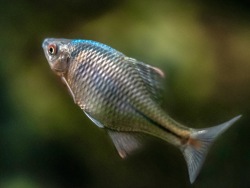With metallic tint: bitterlings put on their spawning dress

The male rose bitterlings (Rhodeus ocellatus) residing in the Rivers and Lakes exhibit have changed colour – their tails and fins have become red, and scales on the back are metallic blue: now the fish are in full spawning dress.
“Such striking colours are only found in males, female bitterlings never develop a bright colouration,” explains Anatoly Semenchenko, Head of the Department of Russian Far East Freshwater Species. “But females also have a distinctive feature – an ovipositor, which is longer than the fish itself. Bitterlings need this long ovipositor to lay their eggs — from 30 to 60 — into the mantle cavity of mussels where the eggs incubate. It's worth noting that the bitterling, in its turn, does the mollusk a favour at some point – when leaving their temporary home, the young fish carry larvae of the mollusk, which are attached to their gills with special denticles, outside.”
The rosy bitterling occurs in the Amur River but it is native to the island of Taiwan. At first, this fish mysteriously made its way to bodies of water in Asia, in particular, the Yangtze River, then it established itself in Russia and reached European countries. The wide distribution of the species has most likely been facilitated by aquarium hobbyists, with whom the fish is quite popular.
General Information:
— The rosy bitterling gets its common name from the reddish colour the males change to during the spawning season.
— In the wild, rosy bitterlings usually spawn in August.
— Besides this species, the Amur River is home to four more species of bitterlings: Russian bitterling (Acanthorhodeus asmussi), Khanka spiny bitterling (Acanthorhodeus chankaensis), bitterling (Rhodeus sericeus) and Light's bitterling (Rhodeus lighti).